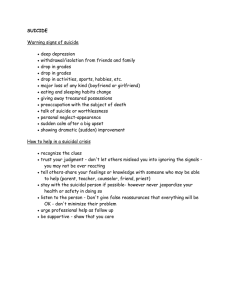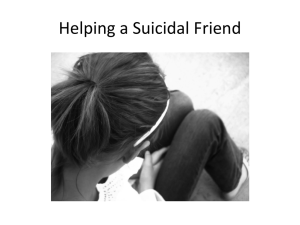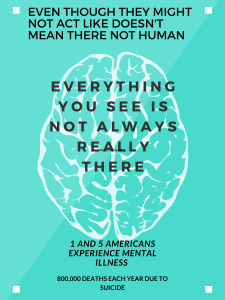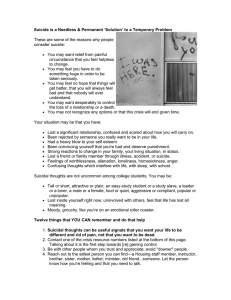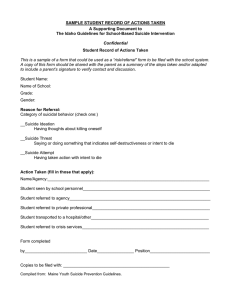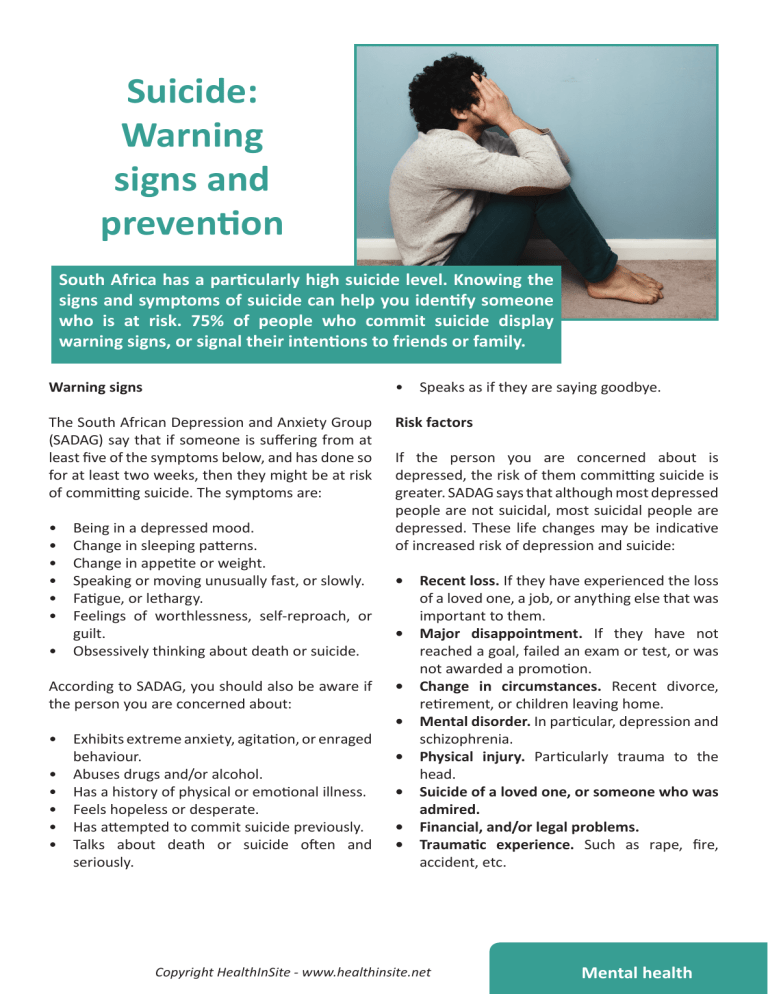
Suicide: Warning signs and prevention South Africa has a particularly high suicide level. Knowing the signs and symptoms of suicide can help you identify someone who is at risk. 75% of people who commit suicide display warning signs, or signal their intentions to friends or family. Warning signs • The South African Depression and Anxiety Group (SADAG) say that if someone is suffering from at least five of the symptoms below, and has done so for at least two weeks, then they might be at risk of committing suicide. The symptoms are: Risk factors • • • • • • • Being in a depressed mood. Change in sleeping patterns. Change in appetite or weight. Speaking or moving unusually fast, or slowly. Fatigue, or lethargy. Feelings of worthlessness, self-reproach, or guilt. Obsessively thinking about death or suicide. According to SADAG, you should also be aware if the person you are concerned about: • • • • • • Exhibits extreme anxiety, agitation, or enraged behaviour. Abuses drugs and/or alcohol. Has a history of physical or emotional illness. Feels hopeless or desperate. Has attempted to commit suicide previously. Talks about death or suicide often and seriously. Speaks as if they are saying goodbye. If the person you are concerned about is depressed, the risk of them committing suicide is greater. SADAG says that although most depressed people are not suicidal, most suicidal people are depressed. These life changes may be indicative of increased risk of depression and suicide: • • • • • • • • Recent loss. If they have experienced the loss of a loved one, a job, or anything else that was important to them. Major disappointment. If they have not reached a goal, failed an exam or test, or was not awarded a promotion. Change in circumstances. Recent divorce, retirement, or children leaving home. Mental disorder. In particular, depression and schizophrenia. Physical injury. Particularly trauma to the head. Suicide of a loved one, or someone who was admired. Financial, and/or legal problems. Traumatic experience. Such as rape, fire, accident, etc. Copyright HealthInSite - www.healthinsite.net Mental health What can you do? If you are concerned about someone, SADAG suggests that you: • • • • • • Be direct. You should ask them what is wrong. Talk openly and unemotionally about suicide, and suicidal thoughts. Listen. You should not try to argue the person out of suicide. Accept the person’s feelings. Be supportive. You should let them know that you care about them and that depression is treatable. Remove means. Sharp objects, pills, firearms etc. should be removed from reach. Don’t judge. Don’t tell the person that they have a lot to live for, or tell them that they would be hurting their family to commit suicide. Don’t act shocked. Offer hope, but not reassurance. Be available. Try to provide as much support as you can, whether emotional or otherwise (like driving them to doctor’s visits). Help them find support, and ask if you can contact a family member. In an emergency • Don’t leave a suicidal person alone in an emergency. • Accompany them to the emergency room, clinic or other appropriate facility. • Call emergency services. Treatment You can help with the recovery of a suicidal person by: • • • Ensuring that the patient takes their prescribed medication. Keeping in contact with their doctor regarding refills, prescriptions, and side effects. Offering emotional support during and after treatment. It is important to remember that some people commit suicide without any warning, but most people do give some kind of warning. Keep an eye out for the warning signs and take action: even if you cannot deal with a suicidal person, there are professional services to help you cope. Copyright HealthInSite - www.healthinsite.net Mental health

